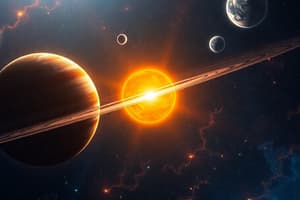Podcast
Questions and Answers
Which planet in our solar system is known as Earth's twin?
Which planet in our solar system is known as Earth's twin?
- Venus (correct)
- Jupiter
- Mercury
- Mars
Which planet in our solar system is the closest to the Sun?
Which planet in our solar system is the closest to the Sun?
- Earth
- Mercury (correct)
- Mars
- Venus
What is unique about Mercury's orbit around the Sun?
What is unique about Mercury's orbit around the Sun?
- It circles the Sun once every three months. (correct)
- It has a perfectly circular orbit.
- It is the slowest orbiting planet.
- It takes 365 days to orbit the Sun.
Which planet in our solar system is considered one of the hottest places?
Which planet in our solar system is considered one of the hottest places?
How many planets are there in our solar system?
How many planets are there in our solar system?
Which planet in our solar system boasts water bodies covering nearly three quarters of its surface?
Which planet in our solar system boasts water bodies covering nearly three quarters of its surface?
Which planet is known for its dramatic red landscapes and ancient riverbeds?
Which planet is known for its dramatic red landscapes and ancient riverbeds?
Which two planets are considered ice giants in the solar system?
Which two planets are considered ice giants in the solar system?
What distinguishes Jupiter and Saturn from the inner rocky worlds of the solar system?
What distinguishes Jupiter and Saturn from the inner rocky worlds of the solar system?
What is a distinguishing feature of Uranus and Neptune's atmospheres?
What is a distinguishing feature of Uranus and Neptune's atmospheres?
Where are the gas giants located in relation to the terrestrial planets in the solar system?
Where are the gas giants located in relation to the terrestrial planets in the solar system?
What region is believed to hold thousands of undiscovered Kuiper Belt Objects?
What region is believed to hold thousands of undiscovered Kuiper Belt Objects?
Flashcards are hidden until you start studying
Study Notes
Exploring Our Place in Space: The Solar System and Beyond
The universe is vast, enigmatic, and endlessly fascinating. One of its most intriguing realms lies close to home — our humble solar system. As we delve into this realm, let's unravel some key aspects of our cosmic neighborhood.
A Solar System, by definition, consists of everything orbiting around our Sun. This radiant star forms the centerpiece of a sprawling family tree with eight main branches known as planets. In order of distance from the Sun these planetary siblings are: Mercury, Venus, Earth, Mars, Jupiter, Saturn, Uranus, Neptune. Each planet has unique characteristics shaping their environments and features, which have been explored extensively throughout history.
For instance, the closest world to us — Mercury — circles the sun once every three months in its elongated dance. With surface temperatures rising upwards of 700°F, it's one of the hottest places in our solar system. Next comes Venus, often called Earth's twin due to similar size and composition. However, instead of life-nurturing oceans beneath its thick atmosphere, it hosts hellish conditions of intense heat and crushing pressure.
Our own blue marble, Earth, boasts water bodies covering nearly three quarters of its surface, creating ecosystems teeming with flora, fauna, and an abundance of human civilization. Following Earth, Mars stands out as the fourth terrestrial planet and the only other one considered potentially habitable under certain circumstances. Its dramatic red landscapes harbor ancient riverbeds, colossal canyons, and tantalizing clues pointing towards possible past life forms.
As you venture further away from the Sun, you reach the gas giants: Jupiter and Saturn. Both of these leviathans dwarf all the inner rocky worlds put together. Their vast, swirling atmospheres contain multicolored bands bordered by storm systems larger than Earth itself. And they also possess numerous moons with diverse geographies ranging from lifeless, cratered surfaces to active volcanic eruptions and subsurface oceans.
Next comes Uranus and Neptune, two ice giant planets wrapped in the brilliance of azure blues and pristine whites. These celestial beings hide many mysteries deep within their frozen hearts, including exotic compositions and complex dynamics shaping their windswept, turbulent atmospheres.
These planets aren't entirely alone though; each one plays host to dozens of moons, some of them quite large themselves, attracting increasing interest from astronomers. Additionally, there exists a mysterious population of small bodies ranging from comets and asteroids to tiny transneptunian objects scattered far beyond Pluto.
In addition to this wealth of information, discoveries continue to expand humanity's understanding of the solar system. For example, recent data indicates the existence of Oort Cloud, a shell-like region believed to hold thousands of undiscovered Kuiper Belt Objects, the seeds of potential new worlds yet to be explored.
Throughout the centuries, humans have shaped marvelous narratives woven across the fabric of space, stitching together tales of countless stars, galaxies, and universes. But before embarking upon such grand journeys, it helps to first appreciate fully the beauty of our very own celestial backyard, our beloved solar system.
Studying That Suits You
Use AI to generate personalized quizzes and flashcards to suit your learning preferences.




